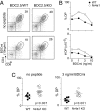Nuclear receptor Nr4a1 modulates both regulatory T-cell (Treg) differentiation and clonal deletion
- PMID: 22345564
- PMCID: PMC3309794
- DOI: 10.1073/pnas.1200090109
Nuclear receptor Nr4a1 modulates both regulatory T-cell (Treg) differentiation and clonal deletion
Abstract
Immature thymocytes expressing autoreactive T-cell receptors (TCR) can adopt differing cell fates: clonal deletion by apoptosis or deviation into alternative lineages such as FoxP3(+) regulatory T cells (Treg). We revisited the role of the transcription factor Nr4a1 (Nur77), an immediate-early response gene induced by TCR engagement. Nr4a1KO mice show clear quantitative defects in antigen-induced clonal deletion. The impact of the Nr4a1 deletion is not enhanced by deletion of the proapoptotic factor Bim. In addition, Nr4a1 curtails initial differentiation into the Treg lineage in TCR transgenic mice and in nontransgenic mice. Transcriptional profiling of Nr4a1KO thymocytes under selection conditions reveals that Nr4a1 activates the transcription of several targets, consistent with these diverse actions: (i) Nr4a1 partakes in the induction of Bim after TCR triggering; (ii) perhaps paradoxically, Nr4a1 positively controls several transcripts of the Treg signature, in particular Ikzf2 and Tnfrsf9; (iii) consistent with its prosurvival and metabolic role in the liver, Nr4a1 is also required for the induction by TCR of a coordinated set of enzymes of the glycolytic and Krebs cycle pathways, which we propose may antagonize Treg selection as does activation of mTOR/Akt. Thus, Nr4a1 appears to act as a balancing molecule in fate determination at a critical juncture of T-cell differentiation.
Conflict of interest statement
The authors declare no conflict of interest.
Figures





References
-
- Hogquist KA, Baldwin TA, Jameson SC. Central tolerance: Learning self-control in the thymus. Nat Rev Immunol. 2005;5:772–782. - PubMed
-
- Bouillet P, et al. BH3-only Bcl-2 family member Bim is required for apoptosis of autoreactive thymocytes. Nature. 2002;415:922–926. - PubMed
-
- Rathmell JC, Lindsten T, Zong WX, Cinalli RM, Thompson CB. Deficiency in Bak and Bax perturbs thymic selection and lymphoid homeostasis. Nat Immunol. 2002;3:932–939. - PubMed
-
- D'Adamio L, Clayton LK, Awad KM, Reinherz EL. Negative selection of thymocytes. A novel polymerase chain reaction-based molecular analysis detects requirements for macromolecular synthesis. J Immunol. 1992;149:3550–3553. - PubMed
-
- Calnan BJ, Szychowski S, Chan FK, Cado D, Winoto A. A role for the orphan steroid receptor Nur77 in apoptosis accompanying antigen-induced negative selection. Immunity. 1995;3:273–282. - PubMed
Publication types
MeSH terms
Substances
Grants and funding
LinkOut - more resources
Full Text Sources
Other Literature Sources
Molecular Biology Databases
Research Materials
Miscellaneous

